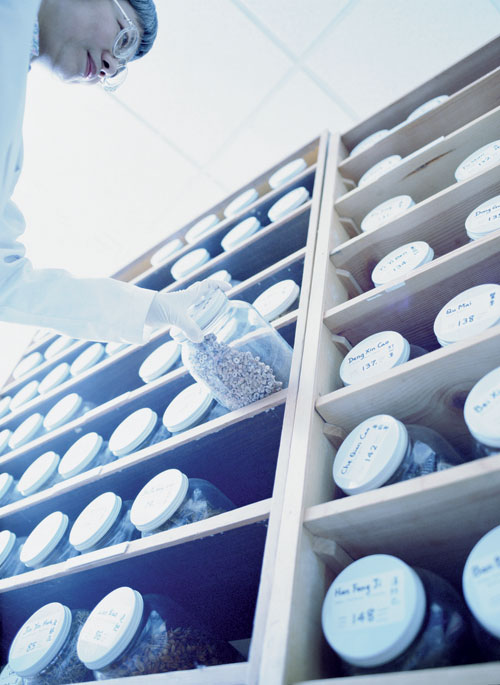January 15, 2011 (Vol. 31, No. 2)
Firm Seeks to Mainstream Ancient Chinese Remedies in U.S. and European Markets
When it comes to scouting out new chemical compounds as potential drug candidates, “we recognized early that China was the place to be,” says Mireille Gingras, Ph.D., founder and CEO of Huya Bioscience International.
Huya is named after the Chinese abbreviations for Shanghai (Hu) and Asia (Ya). Through partnerships with Chinese research institutions and biotechnology companies, Huya identifies new molecular entities and accelerates their worldwide development by providing a bridge into the international development process and global biopharma market. Huya has partnered with a number of large pharmaceutical companies including Abbott, Schering-Plough (now part of Merck), and Solvay Pharmaceuticals (recently acquired by Abbott).
Dr. Gingras formed the San Diego based firm in 2005 with the goal of discovering promising new compounds. Her worldwide travels took her to China, where she learned about a new treatment for Alzheimer disease. “The science was excellent, but the intellectual property was lacking,” recalls Dr. Gingras. From this experience, she recognized that a great pool of scientific talent exists in China, which she subsequently turned into a business opportunity to in-license Chinese drug candidates. Huya has built a continuously expanding portfolio of Chinese compounds to treat oncology, neurology, immunology, and hematology disorders, among others.
Huya currently has a large team of people working in six strategic locations in China, including Shanghai, Beijing, Shenzhen, and Hangzhou, tracking thousands of novel drug compounds and contacts in a wide range of therapeutic areas. The compounds are in various stages of preclinical and clinical development. Huya evaluates these new and innovative compounds for their therapeutic and market potential.
“International companies have an interest in partnerships with us so they can access our abundance of compounds and tap into our network,” says Curtis Tyree, Ph.D., Huya’s senior director of portfolio management and analysis.
The discovery of new compounds is fueled by sea turtles, or Chinese returnees trained as scientists in the U.S. and Europe, many of whom have worked at western pharmaceutical companies. These scientists are lured back by the Chinese government’s recent initiative to modernize traditional Chinese medicine. They are now isolating and purifying the active compounds in traditional Chinese herbal remedies and creating modern formulations to test in randomized, placebo-controlled trials. They also are discovering new biologics and new chemical entities.

Spurred on by the Chinese government’s recent initiative to modernize traditional Chinese medicine, Huya scientists are isolating and purifying the active compounds in traditional Chinese herbal remedies and creating modern formulations to test in randomized, placebo-controlled trials. The company’s ultimate goal is to commercialize new biologics and new chemical entities.
Strategic Partnerships
Huya has established first-look agreements with Chinese government-backed bioscience parks, universities, and research institutions, including the Guangzhou Institutes of Biomedicine and Health, a division of the Chinese Academy of Sciences. Huya also has a strategic partnership with the Taizhou National Medical Hi-tech Development Zone, also known as “China Medical City.”
Located north of Shanghai, China Medical City is the first national industrial-development zone dedicated to the medical and pharmaceuticals industry. “We are the go-to company when it comes to networking in the biotech-pharmaceutical sector in China,” says Dr. Gingras.
Early Pipeline
Huya licenses early-stage, validated compounds for development, and in some cases the originator retains rights to the Chinese market. Depending on the quality of the preclinical data, Huya may conduct further efficacy and toxicity studies in the U.S. needed to support the filing of an IND application with the FDA.
Huya plans to move compounds through Phase II studies, then out-license promising candidates to pharmaceutical or biotechnology firms. This business model reduces the risk, costs, and time for drug development.
Among Huya’s licensed compounds is HBI-8000, a histone deacetylase (HDAC) inhibitor with antitumor properties. Researchers at Chipscreen Biosciences in Shenzhen discovered HBI-8000 using structure-based drug-design methods.
Huya’s second compound, HBI-3000, is a synthetic small molecule anti-arrhythmic derived from a traditional Chinese herbal medicine. It was licensed from the Shanghai Institute of Materia Medica. Huya will conduct Phase I and II trials for both compounds in the U.S., while Phase II studies are ongoing in China.
HBI-8000 is a benzamide small molecule HDAC inhibitor with potential for treating breast, prostate, and liver carcinomas, as well as non-small-cell lung cancer and non-Hodgkin lymphoma. HBI-8000 potently and selectively inhibits key cancer-related HDACs and shows broad spectrum antitumor activity, according to the company.
The anti-arrhythmic compound, HBI-3000, is a multi-ion channel blocker in development with formulations for oral and intravenous routes of administration to treat patients with atrial fibrillation. A serious concern for anti-arrhythmic drugs is an increased risk for sudden death in patients with underlying organic heart disease.
Early data on HBI-3000 suggests that it holds a safety advantage over current anti-AF drugs and may also treat ventricular arrhythmias.“Our hope is that these drugs will benefit patients with serious diseases,” says Dr. Gingras.
Huya has assembled a team of clinical and drug development advisors to help establish and execute a plan for moving each compound forward.
In addition to out-licensing opportunities, Huya also seeks global pharmaceutical partners to co-develop in-licensed novel clinical drug candidates that originate in China.


